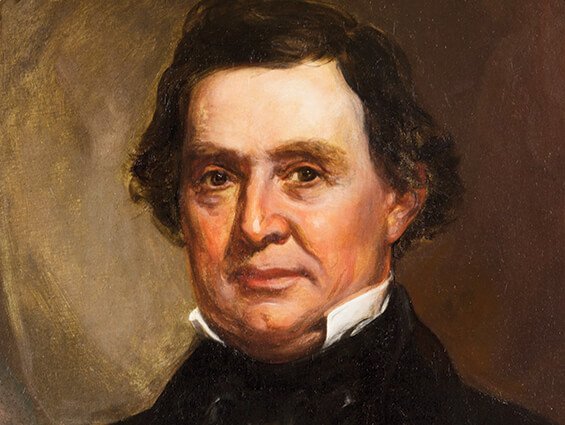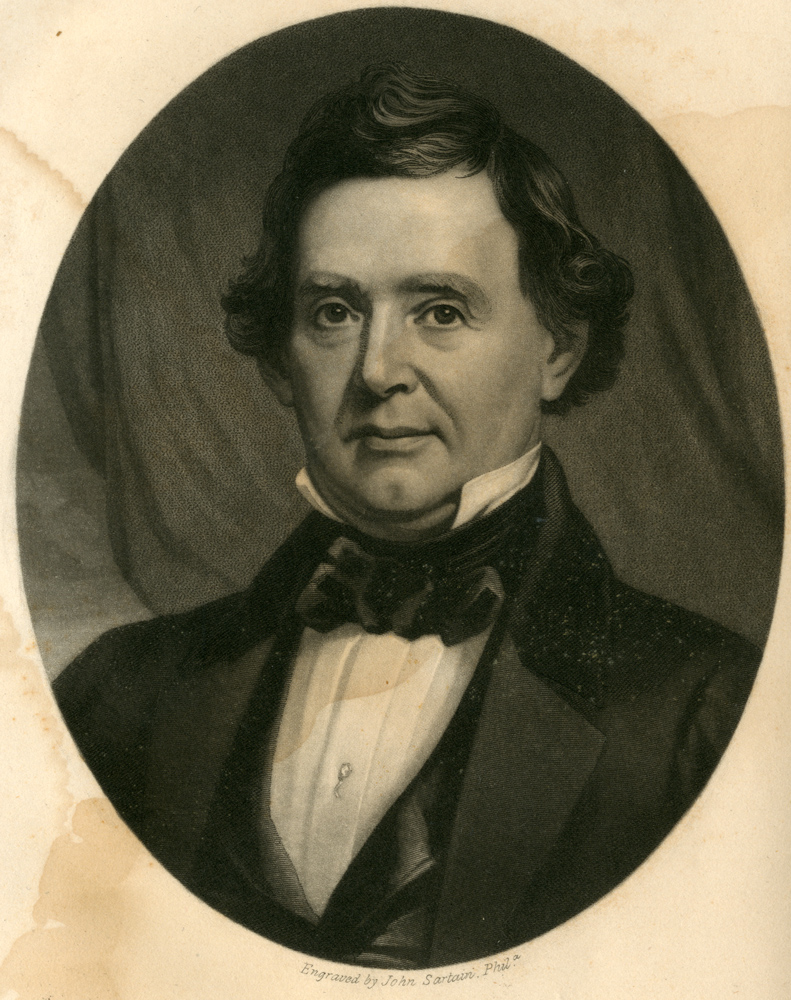Godfrey, Benjamin (1794-1862)
Benjamin Godfrey (1794-1862) was a prominent citizen of the town that now bears his name, Godfrey, Illinois. Over the course of his life, Godfrey had several careers, including ship captain, merchant, investor, and philanthropist. Having lived in Chatham, Massachusetts; Baltimore, Maryland; and Matamoras, Mexico, Godfrey and his family settled in Godfrey in 1832, where he spent the rest of his life. In 1838, Godfrey invested the funds for the formation for the Monticello Women’s Seminary which operated until 1971.
Born in 1794 to Knowles and Mary Ryder Godfrey in Chatham, Massachusetts, Benjamin Godfrey’s father, and possibly his mother, died before he reached the age of three.((There are only a few sources on Benjamin Godfrey’s childhood and what secondary sources there are disagree on the fates of his parents. Whereas the Abraham Lincoln Presidential Library claims he was “orphaned at the age of three” and lived with his uncle until he was nine and “went to sea.” Other sources, such as the Madison County Historical Society, claim only his father died and “three years later, his mother married a sea captain, Caleb Eldredge.” “Benjamin Godfrey Papers, 1848-1859,” Chronicling Illinois, Abraham Lincoln Presidential Library, accessed February 2, 2019. “Captain Benjamin Godfrey,” Madison County Historical Society: MCHS News 4, No. 6 (November 2016), 5.)) Remaining in Chatham, he was adopted by his uncle, Caleb Eldredge, a sea captain.((Caleb Eldredge may have been the man his mother married after the death of his biological father.)) At the age of nine, Godfrey began his career at sea which led him into naval service during the War of 1812. During his time in the navy, Godfrey navigated ships as a merchant marine throughout the Atlantic and after the war became captain of his own merchant ship.((“Benjamin Godfrey Papers, 1848-1859.”))
During his time as a captain, Godfrey sailed the Atlantic Ocean, amassing his first of many fortunes. He rarely spoke of this time in his life, but ship manifests during this era demonstrate ‘cargo’ as including enslaved people as well as consumable goods. By 1808, it was illegal for ships sailing under the American flag to partake in the trans-Atlantic slave trade. Transportation of enslaved people between states, however, was legal, and the interstate slave trade rapidly grew from the 1820s until the Civil War.((For more about the interstate slave trade or Second Slavery in the United States see, Edward E. Baptist, The Half Has Never Been Told: Slavery and the Making of American Capitalism (New York: Basic Books, 2017). Walter Johnson, Soul by Soul: Life Inside the Antebellum Slave Market (Cambridge: Harvard University Press, 1999).)) In this way, Godfrey may have been involved in illegal contraband smuggling of enslaved people through the trans-Atlantic slave trade if he sailed under the American flag, or he may have transported them between ports within the United States. Either way, most sources concur that Godfrey was involved with the slave trade.((“Benjamin Godfrey Papers, 1848-1859;” John J. Dumphy, “A Brief History of Monticello College in Godfrey, Illinois,” Medium, accessed on February 20, 2019. )) On top of Godfrey’s possible involvement in the slave trade, some sources speculate he was also associated with the activities of the infamous pirate Jean Lafitte.((John J. Dumphy, “A Brief History of Monticello College in Godfrey, Illinois.”)) Remarking on this period of his life, Godfrey stated, “all which he could ever accomplish would do nothing toward repairing the evil he had wrought by his previous life of sin.”((Benjamin Godfrey as quoted in “Captain Benjamin Godfrey,” Madison County Historical Society, 5.))
Around 1820, Godfrey was part of a shipwreck that occurred near Brazos Santiago, Mexico, where he lost his first fortune and nearly his life.((“Benjamin Godfrey Papers, 1848-1859.”)) Stranded with no resources, Godfrey rose through the ranks of a mercantile house in Matamoras where, after nine years, he amassed another fortune only to lose it again when bandits robbed the wagon train transporting his fortune to the United States.((“Godfrey Campus History,” Lewis and Clark Community College, accessed on February 2, 2019. )) Once back in the United States, he met Winthrop S. Gilman and opened a mercantile partnership called Godfrey, Gilman, and Company in New Orleans, and in 1832 the Company opened a storage and commission business in Alton, Illinois.((“Benjamin Godfrey Papers, 1848-1859.”)) In 1834, Godfrey and his family settled north of Alton in what is known today as Godfrey Township in Madison County.((Ibid.)) Sources are unclear as to when Godfrey met and married his wife, Harriet Cooper, but by the time he moved to Illinois he had six children, only three of whom survived.((“Captain Benjamin Godfrey,” Madison County Historical Society, 5.))
Once in Illinois, Godfrey bought the stone residence built by Calvin Riley and soon owned “approximately ten thousand acres of land, most of which lay in Godfrey Township.”((“Benjamin Godfrey Papers, 1848-1859.”)) By 1835, Godfrey, Gilman, and Company had gained control of the State Bank of Illinois, and Godfrey was one of the most influential citizens in the area.((Godfrey, Gilman, and Company would maintain control of the bank until the Panic of 1837. Ibid.)) Godfrey had moved past his involvement with the slave trade and grew opposed to slavery, and he rented a warehouse to one of the era’s most well-known abolitionists, Elijah P. Lovejoy, for his printing press.((“Captain Benjamin Godfrey,” Madison County Historical Society, 5.)) It was at this warehouse where a mob killed Lovejoy for his printing of abolitionist literature. However, Godfrey’s interaction with Lovejoy was most likely transactional rather than ideological.((Ibid.))
Having amassed his third fortune, Godfrey embarked on his first of many philanthropist projects that benefitted his community. After joining a Presbyterian congregation 1832, Godfrey built a stone church at the corner of Third and Market in Alton, the town’s first religious building.”((Ibid.)) In 1845, he donated the building to St. Paul’s Episcopal congregation, which still occupies it today.((History of Madison County, Illinois with Biographical Sketches of many Prominent Men and Pioneers (Edwardsville, Il: W.R. Brink & Co, 1882), 308.)) Godfrey, however, made his largest donation in 1838 of 15 acres of land and $53,000 for the construction of buildings for the Monticello Women’s Seminary.((“The Seventy-Fifth Anniversary of the Founding of Monticello Seminary, at Godfrey Illinois,” Journal of the Illinois State Historical Society (1908-1984) 6, No. 2 (July, 1913), 264.)) Met with great fanfare as the “pioneers of Illinois were ambitious for their daughters to have the opportunities which their isolation from schools of the east and south seemed to deny them,” as stated at the college’s 75th anniversary.((Ibid.)) When asked what inspired him to build the school, Godfrey wrote that he was watching his children with their mother one day and “reflect[ed] on the powerful effect of a mother’s example on the minds, matters, and habits of their offspring.”((“Benjamin Godfrey to Rev. Theron Baldwin 1842,” as quoted in “Captain Benjamin Godfrey,” Madison County Historical Society, 5.)) Created to provide young women moral, intellectual, and domestic instruction, Monticello Women’s Seminary opened its doors on April 11, 1838, and continued operations for 133 years until 1971 when Lewis and Clark Community College bought the land.((Ibid.; “Captain Benjamin Godfrey.”))
Engraving of Benjamin Godfrey by John Sartain of Philadelphia
From A. T. Norton, History of the Presbyterian Church in the State of Illinois. Vol I (St. Louis: W. S. Bryan, 1879), 701.
A few months after the opening of Monticello Women’s Seminary, Godfrey’s wife Harriet died. The following year he married Rebecca Eleanor Pettit, who was twenty-four years his junior. The couple had three children together, two of whom survived to adulthood.((“Captain Benjamin Godfrey,” 6.))
From 1840 until his death in 1862, Godfrey continued land speculation and at one point owned more than 10,000 acres of land in Madison County, the majority in Godfrey Township. He also made substantial investments in lead mines in Galena and helped establish Alton’s first bank.((Ibid.)) He also planted the first orchard in Madison County, and was one of the first to manufacture the stationary threshing machine.((“Captain Benjamin Godfrey.”)) Benjamin Godfrey died of apoplexy on August 13, 1862 and was survived by eight children (of the fifteen from both of his marriages) and his wife, Rebecca.((Ibid.))
Benjamin Godfrey did not leave his namesake on the buildings he built and knew the town he lived in as Monticello. When Madison County opened a post office there, however, they could not call it Monticello because there was already a town by that name in central Illinois, near Decatur. Instead, they named it Godfrey Post Office in Monticello and eventually changed the name of the town to Godfrey.((“Captain Benjamin Godfrey,” 7.))


